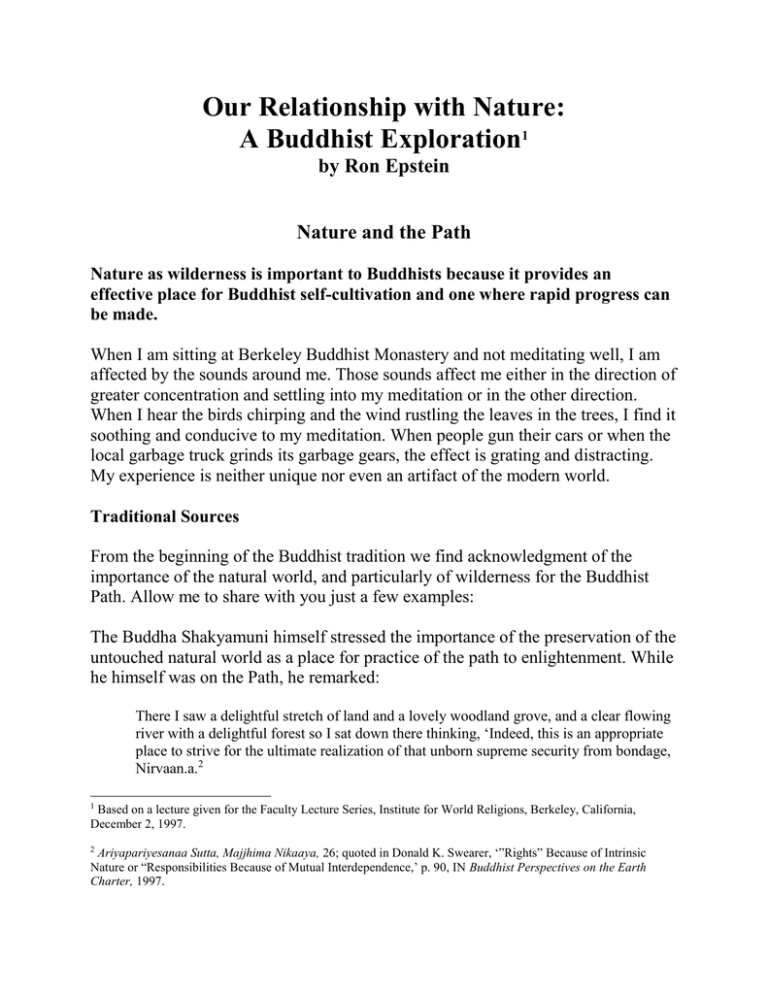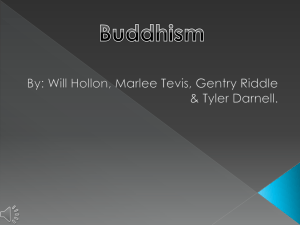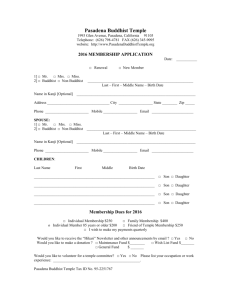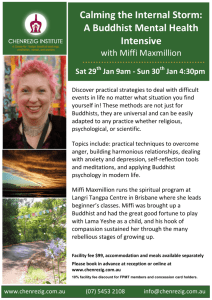Our Relationship with Nature
advertisement

Our Relationship with Nature: A Buddhist Exploration1 by Ron Epstein Nature and the Path Nature as wilderness is important to Buddhists because it provides an effective place for Buddhist self-cultivation and one where rapid progress can be made. When I am sitting at Berkeley Buddhist Monastery and not meditating well, I am affected by the sounds around me. Those sounds affect me either in the direction of greater concentration and settling into my meditation or in the other direction. When I hear the birds chirping and the wind rustling the leaves in the trees, I find it soothing and conducive to my meditation. When people gun their cars or when the local garbage truck grinds its garbage gears, the effect is grating and distracting. My experience is neither unique nor even an artifact of the modern world. Traditional Sources From the beginning of the Buddhist tradition we find acknowledgment of the importance of the natural world, and particularly of wilderness for the Buddhist Path. Allow me to share with you just a few examples: The Buddha Shakyamuni himself stressed the importance of the preservation of the untouched natural world as a place for practice of the path to enlightenment. While he himself was on the Path, he remarked: There I saw a delightful stretch of land and a lovely woodland grove, and a clear flowing river with a delightful forest so I sat down there thinking, ‘Indeed, this is an appropriate place to strive for the ultimate realization of that unborn supreme security from bondage, Nirvaan.a.2 1 Based on a lecture given for the Faculty Lecture Series, Institute for World Religions, Berkeley, California, December 2, 1997. Ariyapariyesanaa Sutta, Majjhima Nikaaya, 26; quoted in Donald K. Swearer, ‘”Rights” Because of Intrinsic Nature or “Responsibilities Because of Mutual Interdependence,’ p. 90, IN Buddhist Perspectives on the Earth Charter, 1997. 2 One of the twelve or thirteen ascetic practices recommended by the Buddha is dwelling in the forest, i.e., wilderness. The Path of Purification states: A forest-dwelling bhikkhu who has given attention to the perception of forest (see M. sutta 121) can obtain hitherto unobtained concentration, or preserve that already obtained. And the Master is pleased with him, according as it is said ‘So, Naagita, I am pleased with that bhikkhu’s ‘dwelling in the forest’ (A. iii 343). And when he lives in a remote abode his mind is not distracted by unsuitable visible objects, and so on. He is free from anxiety; he abandons attachments to life; he enjoys the taste of the bliss of seclusion, and the state of the refuse-rag wearer, etc., becomes him.3 2) In the biography of Ajahn Mun (1870-1949), a great Thai Buddhist and forest meditation master, we learn: Staying in the wilds. From the early days of his practice the Venerable Acharn realized the great merit of staying in the wilds, by which he was blessed with peaceful seclusion. All around is the scenery which awakens heedfulness. While sitting, standing, walking, or lying down, mindfulness is always present with wisdom in contemplating the dharma, both internally and externally [bold added]. This goes on continuously, except during sleep. Relief and bouyancy reign in every posture of the body. With no bondage or compulsion to weigh the mind down, the prospects for Deliverance appear increasingly brighter. The more desolate and distant the place is from human habitation, with wild beasts roaming freely about, the more prepared is the mind to soar up from the abyss of defilements, being at all times like a bird about to fly. The defilements are still there in the depths of the mind, but in such an environment the power of the mind is greatly developed and appears to have gotten rid of hundreds of defilements, with only few remaining. This is the influence of environment which gives encouragement to an aspirant at all times.4 3) The poems of the Chinese Chan Master Deqing (7th cent. CE), who is also known by his mountain Han Shan (“Cold Mountain”), are filled with images of Nature as wilderness. Here is an example: Poem #22 There is a master who eats the pink clouds; His abode shuns the haunts of the common. 3 Buddhaghosa (ca. 5th cent. CE). The Path of Purification, II, 54, 55. 4 The Venerable Phra Acharn Mun Bhuridatta Thera, Meditation Master, p. 41. As for the seasons—truly crisp and cool; In summer it’s just like the fall. Secluded brooks--constant gurgle and splash; Through tall pines the wind sighs and moans. In here if you sit half a day, You’ll forget the cares of one hundred years.5 The Chinese Chan Patriarch, the Venerable Master Hsu Yun (1840-1959) commented: Since entering Sichuan that year , I had walked alone with only a bowl and the proper garments of a monk, thus being entirely free from all hindrances. As I wound my way across mountains and rivers, the scenery helped to clarify my mind.6 The German Buddhist scholar Lambert Schmithausen, who has written extensively on Buddhism and nature and Buddhism and plants, aptly summarizes Buddhist attitudes towards nature this way: …there has also been, since the time of Early Buddhism, a counter-attitude appreciating life in the solitude of wild nature. This is the attitude of the forest-dwelling monk, the hermit, who is no longer afraid of the wild animals because he on his part does not threaten them but offers them safety and friendship; who is happy in the solitude of the wilderness because he has abandoned worldly desires and is content with little (appossuka, appiccha, santut.t.ha). Of course, remote places may also offer protection from social or political disturbances. But the main motive for the Buddhist monk are the spiritual benefits of wilderness. To be sure, nature in the form of biting and stinging insects can be a nuisance, but the hermit can learn to endure them, and on the whole the solitude and silence of the wilderness is most favourable to meditation. The beauty of nature is enjoyed by the hermit without attachment. Its contemplation is recommended especially to persons who need encouragement. Natural things, especially plants, may even arouse discriminating insight by displaying impermanence, e.g., by the falling of the leaves, the withering of flowers, or the change of the seasons.7 Translation by Robert G. Hendricks, The Poetry of Han-Shan: A Complete, Annotated Translation of Cold Mountain. 5 6 Empty Cloud: the Autobiography of Chan Master Xuyun, p. 28 (in his 48th year) 7 Buddhism and Nature, pp. 18-19. I do not think that these ideas are at all alien to those of us who seek solace in Nature--hiking in the mountains, walking on an isolated stretch of beach, or even quietly sitting in a small urban park. What though is particularly Buddhist about this understanding of Nature? Why is it that natural sights and sounds have such different effects on us than those of modern civilization? How can Buddhist teachings explain what it is about Nature as wilderness that is so helpful to progress on the Path? What the passages above tell us is that in the wilderness the practitioner’s “mind is not distracted by unsuitable visible objects, and so on; that he is free from anxiety; he abandons attachments to life…;” that wilderness scenery is conducive to mindfulness and mental clarity; and that afflictions naturally disappear from the outer layers of the mind. Furthermore, Nature provides an opportunity for developing an understanding of impermanence. It is by observing the changing of the seasons and the unversality of impermanence in the natural world that some Buddhist practitioners awaken to their true nature: The holy sages enlightened to conditions (pratyekabuddha) Doze high on mountain peaks alone. Springtime’s flowers wither in the fall In an interconnected cycle of twelve links.8 Nature acts as a mirror for seeing the deep workings of our own body-minds. When we strip away the veneers of civilized distortions, then we are allowed access to layers of our body-minds that civilization, in its negative aspects, tries to cover over in defense of superficial alienated aspects of the constructed looking glass self. In the wilderness the distinctly human afflictions of others do not reinforce our own afflictions. During all our waking hours, and perhaps even while dreaming, we broadcast our thoughts and emotions and receive the broadcasted thoughts and emotions of other sentient beings. We receive them through our six senses, which include the faculty of mind or sixth consciousness. The isolation of wilderness affords us a refuge where the broadcasted afflictions of other humans are only weakly received by the faculty of mind and not at all by the other senses. It is then only natural that afflictions, almost all of which are interpersonally based, begin to settle out of our waking awareness. As we begin to realize that our mental well8 Ch’an Master Hsuan Hua, The Ten Dharma-Realms Are Not beyond a Single Thought, p. 29. being is enhanced rather than threatened by a leaving behind of interpersonal attachments, our minds become buoyant. Buddhist Understanding of Nature Contrasted with Western Notions For Buddhists Nature is alive and, in its sentient aspects, aware. It is neither sacred, nor evil, nor threatening. The nature of Nature is empty of natural kinds or essences; its ultimate nature is the Buddha-nature. Yet, on the everyday level of understanding, Nature can change according to the karma of sentient beings. In the West we have a polarization between, on the one hand, scientific views of nature as machine to be exploited or as a source of danger to be subdued, and, on the other hand, nature as romantic source of all that is good and wonderful in the world. Buddhism takes a Middle Path between these extremes. Nature is neither ultimately good nor ultimately bad. We are neither completely separate from it nor should we totally identify with it. For Buddhism, unlike many other religious views, nature is not considered sacred; it is not considered innately good, ideal or perfect, nor is it romanticized. For Buddhism, Aristotle’s natural kinds have no reality. Nature is not comprised of real essences that can be studied, understood or even worshipped. It is not a repository of wisdom. Yet we cans till learn important lessons from it. Unlike science’s understanding of nature, for Buddhism, Nature encompasses mind and spirit; life is not merely understood in physical terms, but in terms of awareness, consciousness, and the experience of happiness, pain and suffering. From the Buddhist view, we are not separate from Nature, but Nature does not define us. Yet humans are not separate from other living creatures, nor are they intrinsically superior. All sentient beings are considered to have the Buddhanature, that is, the potential to become fully enlightened. There is no human/nonhuman duality to lead to the treating of non-human life as objects for human use or consumption. It is hard to fit the category ‘nature’ in the Western sense into the technical categories of Buddhist philosophy; among the lists of Buddhist dharmas, there is not a single dharma or set of dharmas that correspond to the idea of nature in the Western sense. Nonetheless, it could perhaps be understood in Buddhist terms as the conditioned world prior to extreme human distortion of the patterns of interrelationship between humans and the rest of the living beings on the planet, both sentient and insentient. Nature is seen as what is technically known as a “dependent karmic result”; it results from the interrelated shared karma of all sentient beings. Since Nature consists of the patterns of shared karma of all sentient beings on the planet, rather than sentient beings being a product of Nature, Nature is dependent on the actions of sentient beings for its creation. Further, as the karma of sentient beings changes, nature changes. Nature as we experience it has no independent existence apart from the karma of sentient beings. Yet the true nature of Nature is its Buddha-nature, even though there is neither any entity Nature that can be accorded an essential nature, nor any entities within nature that can be accorded an essential nature. Although Nature is a conventional designation for an interdependent and interconnected pattern of beings, both sentient and non-sentient. What is ultimately real about all that is its Buddhanature, or its Buddha-ness if you prefer. When our karma is purified to the extent that it allows us to experience the true nature of nature, we live in a pure land or Buddhaland. That Buddhaland is not somewhere else, but right here. The Sixth Chan Patriarch the Venerable Huineng said: …the enlightened person purifies his own mind. Therefore, the Buddha said, “As the mind is purified, the Buddhaland is purified.”9 Buddhism and Social Action This leads to an important question: if we can transform our polluted and defiled world into a pure Buddhaland exclusively through the transformation of our own minds, does that mean that social action to combat environmental problems is irrelevant? Does that mean that we can pollute and harm life with impunity? The answer is no on both counts. Enlightened beings don’t harm life. If they did, they would not be enlightened beings. They also have compassion for those living beings who are attached to our polluted Saha world, filled with pain and suffering, and who do not experience themselves as living in a pure Buddhaland. 9 The Sixth Patriarch’s Dharma Jewel Platform Sutra, p. 141. The process of Buddhist practice or self-cultivation is done in relation to the natural world. There is a reciprocal relationship between our own minds and mindin-the-world, that is the interrelated consciousnesses or awarenesses that we experience as other life. Remember the passages that I began the talk with about the effect of nature on this process. Nature as wilderness, apart from the afflicted disruptions of so-called human civilization, hastens the process, for those advanced enough to deal with that kind of situation. By looking inward, within one’s own body-mind, one gradually realizes that there is no ultimate division between inside and outside, that the patterns of the natural world are not separate from the patterns of our own body-minds. Those patterns are not considered an ultimate truth or the goal; that is beyond them. But the Path to the beyond must lead through them. As one’s mind is purified, one’s actions are purified. As a result, not only do mental attitudes that are dissonant or harmful to Nature disappear, but one’s new mental states leaded directly to more enlightened actions in relation to Nature and more enlightened influence on others about Nature. There is also influence from action to mind. As we act more responsibly towards life in Nature or life as Nature, the more our actions will purify and clarify our minds. Consideration of our actions then leads us to our ethical behavior. Our Actions in Nature The core of Buddhist karma-based ethics is respect for life, particularly sentient life. The starting place for understanding just about anything about Buddhism is karma. Karma is the network of causation, both mental and physical, that is the foundation of Buddhist ethical understanding. The foundation of Buddhist ethics is ahim.sa, the principle of non-harming or respect for life. This does not only refer to respect for human beings, but also for every manifestation of life on the planet, especially sentient life. In Buddhism humans are not fundamentally alienated from nature. There is no mind-body duality to lead to the devaluation of the natural, physical realm. All life is interrelated and interdependent on physical, mental, and ethical planes. Unlike the perspective of quantum physics, the Buddhist emphasis is on the causal interrelation of mind/Mind and matter/energy. The emphasis is on intention in creating karma, and on responsibility for actions. Purposeful action in the world starts with intentions in the mind. One tries to realize the potential for freedom of decision in every present moment. In Buddhism, all sentient lives have intrinsic value because they have the Buddhanature, the inner potential for realizing perfect enlightenment. The non-reality of the constructed selves leads to the breakdown of barriers between beings and the breakdown of the concept that karma and killing can be isolated. Realizing our potential for enlightenment involves dissolving the illusions of separateness and conflict of interest that alienate us from the rest of life. As those illusions disappear, we begin to realize that we are not insulated from the sufferings of other sentient beings, and that what is enlightened within us, we share with all life. If we fail to respect life, we, therefore, obstruct our own realization of enlightenment. Understanding the extent of the harm we are doing: In order to increase our respect for life we need to become more aware of the nature and severity of the harm to life that we are doing? Then we can take action to reduce that harm. With regard to the natural world, we might consider: Harming and killing non-human sentient beings, either directly or indirectly (e.g., destroying their habitat, buying animal products), contributing to their environmentally caused illness and death through pollution, etc. Harming ecosystems leads to short or long-term harm to individual beings and loss of their lives. What can we do to reduce harm to life and benefit it Buddhists need to calculate the true karmic cost of our activities. For example: Food: The karmic cost of the food includes not only the farmers’ work, but the insects killed in growing the food, the soil and water depleted and/or polluted, the packaging, the transportation and distribution, etc. Shelter: materials, labor, electricity, heat, water, cleaners. ETC. We can analyze the reasons, ignorance, etc, that we persist in our behavior: craving, laziness, other supports to our constructed sense of ego-self. We can use our minds to generate compassion instead of greed, anger, distrust, etc. We can be mindful of respect for life and the potentials for the harmony of all living creatures. When we quiet our minds, we observe their resonance with living Nature. We can be more aware of the benefits for other life on the planet that we are creating through our activities that balance the harm we do: a) physically aiding life at different levels; b) ending the suffering of people and other sentient beings. In the modern world monastic communities need to develop new awarenesses of nature that are based on old principles. For example: a) recycling; b) are developing new awarenesses of what goes into the air, earth and water there; c) planting trees; d) in liberating birds and animals originally consigned to death they are developing a new ecologic concern for suitability of releases and habitat. e) teaching these principles to young people. (Or perhaps more often the young people are teaching these principles to their elders.) Of course many other Buddhist organizations have also realized the importance of these concerns. The key to right understanding of Buddhist relations with nature is making sure that one’s activism in the world is not outstripping the activism in one’s own mind. Otherwise, good intentions are distorted by actions that are karmically unclear because of our inner mental pollution. An Example of Our Actions in Nature: Ecosystem Management Of Deer And Mountain Lion Habitat We can use this contemporary problem to illustrate differences between a Buddhist approach to Nature and scientific systems-based understanding. First, let us look at the scientific ecological view based on the Gaia self-organizing system model: If there is no human interference, a natural balance will exist among the number of mountain lions and the number of deer and the habitat acreage available for them. The relations among the three factors is seen as a self-organizing system. a) grazing land for the deer.—how many deer can be supported. b) mountain lions serve the function of making sure there are not too many deer for the land. c) If there are not enough deer then there is not enough food for the mountain lions. The ecosystem naturally keeps itself in balance unless there is human interference. PROBLEM: Humans have disrupted the ecosystem by: a. killing mountain lions b. restricting the available habitat for both deer and mountain lions Since not enough land is available for mountain lions, deer and humans, then humans have decided to manage the ecosystem, that is, to decide on the numbers and balance of mountain lions and deer, i.e., how many deer should be killed and how many mountain lions should be killed. De facto values usually operating: 1) Humans have the right to displace deer and mountain lions from their habitat. 2) Humans have the right to decide which animals should live and which animals should die. 3) Humans have a responsibility to intervene. 4) Human management through selective killing is better than die-off of deer from starvation and/or disease or “over-killing” of deer by mountain lions. 5) Encroachment of mountain lions in human habitat areas or human livestock areas can only be tolerated in a very limited way. 6) Human hunters of deer have precedence over mountain lions when deciding quotas. Other assumptions: 7) The lives of deer and mountain lions have no individual intrinsic value apart from the ecosystem. 8) There is only one possible ‘solution’ to the ecosystem problem in terms of the three-fold equilibrium. Buddhist Paradigm On first sight Buddhism may seem similar to a modern ecological view Of interdependency in self-regulating ecosystems. Here are some of the differences: The goal is not system equilibrium but enlightenment of all beings, which means radical transformation of the karma-based equilibria. a) karma and ends-means analysis b) long-term versus short-term goals c) not just one ecosystem equilibrium d) rebirth factor e) mental dispositions dimension In other words, the current ecological equilibrium is not divinely ordained and valued as such. It is the temporary and changeable result of the shared karma of deer, mountain lions, humans, etc. That karma involves karma and killing, therefore it is flawed and leads to future suffering/unsatisfactoriness (duh.kha). In whatever situation the lives of individual sentient beings are not respected and preserved, there is a problem. If the karma of living beings improves, then the equilibrium points will shift. (See Buddhist notion of pure lands with no bad karma. A completely different equilibrium is assumed.) Up till now the Buddhists have not taken the view that ecosystems are sentient lifeforms. [On the model of killing bacteria and viruses within the body to keep healthy] Therefore, there is no excuse for killing for the sake of the ecosystem. From the Buddhist perspective, the primary directive is the non-harming of life in the short- and the long-term, not lack of diversity. Lack of diversity is only a problem insofar as it arises from lack of respect for life and the harming of life. More killing just adds to the problem. Finally, from a Buddhist perspective mountain lions have a potential for choice about whether they eat deer. They are not necessarily ‘natural born killers’. Eating of deer is not seen as their purpose in life. They have a choice. To illuminate what I mean about the mountain lions, the big cats, having a choice, I would like to relate a true story about two ‘little cats’. For many years I lived next door to some Buddhist vegetarian neighbors who had two cats. They had tried to raise both cats as vegetarians but only one would cooperate. To try to keep the non-vegetarian cat from killing birds, they had to feed it non-vegetarian cat food. Everyday the cats ate side by side, one out of a bowl of vegetarian food, the other out of a bowl of non-vegetarian food. The vegetarian cat never ate the nonvegetarian food, even though it was right in front of him. From this story we can see that even cats can exercise their potential for choice, even if it goes against their so-called ‘nature.’ How much the more so should we consider humans to have the potential to make the right choices about our actions in nature!





